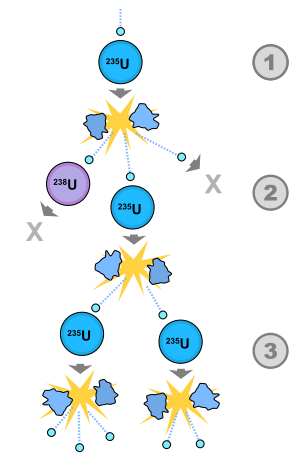This article needs additional citations for verification. (October 2024) |

1) A uranium-235 atom absorbs a neutron and fissions into two fission fragments, releasing three new neutrons and a large amount of binding energy.
2) One of those neutrons is absorbed by an atom of uranium-238, and does not continue the reaction. Another neutron leaves the system without being absorbed. However, one neutron does collide with an atom of uranium-235, which then fissions and releases two neutrons and more binding energy.
3) Both of those neutrons collide with uranium-235 atoms, each of which fissions and releases a few neutrons, which can then continue the reaction.
In nuclear physics, a nuclear chain reaction occurs when one single nuclear reaction causes an average of one or more subsequent nuclear reactions, thus leading to the possibility of a self-propagating series or "positive feedback loop" of these reactions. The specific nuclear reaction may be the fission of heavy isotopes (e.g., uranium-235, 235U). A nuclear chain reaction releases several million times more energy per reaction than any chemical reaction.